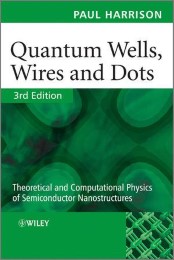-
Zusatztext
-
InhaltsangabePreface Acknowledgements About the author(s) About the book Introduction 1 Semiconductors and heterostructures 1.1 The mechanics of waves 1.2 Crystal structure 1.3 The effective mass approximation 1.4 Band theory 1.5 Heterojunctions 1.6 Heterostructures 1.7 The envelope function approximation 1.8 The reciprocal lattice 2 Solutions to Schrödinger's equation 2.1 The infinite well 2.2 Inplane dispersion 2.3 Density of states 2.4 Subband populations 2.5 Finite well with constant mass 2.6 Effective mass mismatch at heterojunctions 2.7 The infinite barrier height and mass limits 2.8 Hermiticity and the kinetic energy operator 2.9 Alternative kinetic energy operators 2.10 Extension to multiple-well systems 2.11 The asymmetric single quantum well 2.12 Addition of an electric field 2.13 The infinite superlattice 2.14 The single barrier 2.15 The double barrier 2.16 Extension to include electric field 2.17 Magnetic fields and Landau quantisation 2.18 In summary 3 Numerical solutions 3.1 Shooting method 3.2 Generalised initial conditions 3.3 Practical implementation of the shooting method 3.4 Heterojunction boundary conditions 3.5 The parabolic potential well 3.6 The Pöschl-Teller potential hole 3.7 Convergence tests 3.8 Extension to variable effective mass 3.9 The double quantum well 3.10 Multiple quantum wells and finite superlattices 3.11 Addition of electric field 3.12 Quantum confined Stark effect 3.13 Fieldinduced anticrossings 3.14 Symmetry and selection rules 3.15 The Heisenberg uncertainty principle 3.16 Extension to include band non-parabolicity 3.17 Poisson's equation 3.18 Selfconsistent SchrödingerPoisson solution 3.19 Computational implementation 3.20 Modulation doping 3.21 The high-electron-mobility transistor 3.22 Band filling 4 Diffusion 4.1 Introduction 4.2 Theory 4.3 Boundary conditions 4.4 Convergence tests 4.5 Constant diffusion coefficients 4.6 Concentration dependent diffusion coefficient 4.7 Depth dependent diffusion coefficient 4.8 Time dependent diffusion coefficient 4.9 !doped quantum wells 4.10 Extension to higher dimensions 5 Impurities 5.1 Donors and acceptors in bulk material 5.2 Binding energy in a heterostructure 5.3 Twodimensional trial wave function 5.4 Threedimensional trial wave function 5.5 Variablesymmetry trial wave function 5.6 Inclusion of a central cell correction 5.7 Special considerations for acceptors 5.8 Effective mass and dielectric mismatch 5.9 Band nonparabolicity 5.10 Excited states 5.11 Application to spin-flip Raman spectroscopy 5.12 Alternative approach to excited impurity states 5.13 The ground state 5.14 Position dependence 5.15 Excited States 5.16 Impurity occupancy statistics 6 Excitons 6.1 Excitons in bulk 6.2 Excitons in heterostructures 6.3 Exciton binding energies 6.4 1s exciton 6.5 The twodimensional and threedimensional limits 6.6 Excitons in single quantum wells 6.7 Excitons in multiple quantum wells 6.8 Stark Ladders 6.9 Selfconsistent effects 6.10 Spontaneous symmetry breaking 6.11 2s exciton 7 Strained quantum wells, V. D. Jovanovíc 7.1 Stress and strain in bulk crystals 7.2 Strain in quantum wells 7.3 Strain balancing 7.4 Effect on the band profile of quantum wells 7.5 The piezoelectric effect 7.6 Induced piezoelectric fields in quantum wells 7.7 Effect of piezoelectric fields on quantum wells 8 Simple models of quantum wires and dots 8.1 Further confinement 8.2 Schrödinger's equation in quantum wires 8.3 Infinitely deep rectangular wires 8.4 Simple approximation to a finite rectangular wire 8.5 Circular cross-section wire 8.6 Quantum boxes 8.7 Spherical quantum dots 8.8 Nonzero angular momentum states 8.9 Approaches to pyram
-
Detailansicht
Quantum Wells, Wires and Dots
Theoretical and Computational Physics of Semiconductor Nanostructures
ISBN/EAN: 9780470770979
Umbreit-Nr.: 1361005
Sprache:
Englisch
Umfang: XXV, 538 S.
Format in cm: 2.6 x 23 x 15.2
Einband:
kartoniertes Buch
Erschienen am 18.12.2009
Auflage: 3/2009


